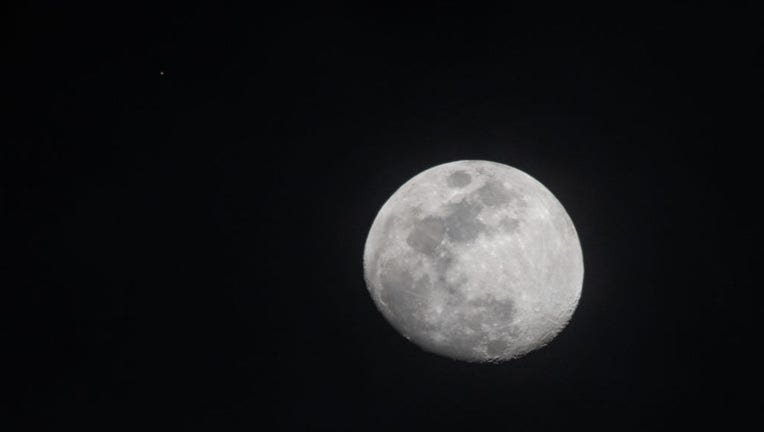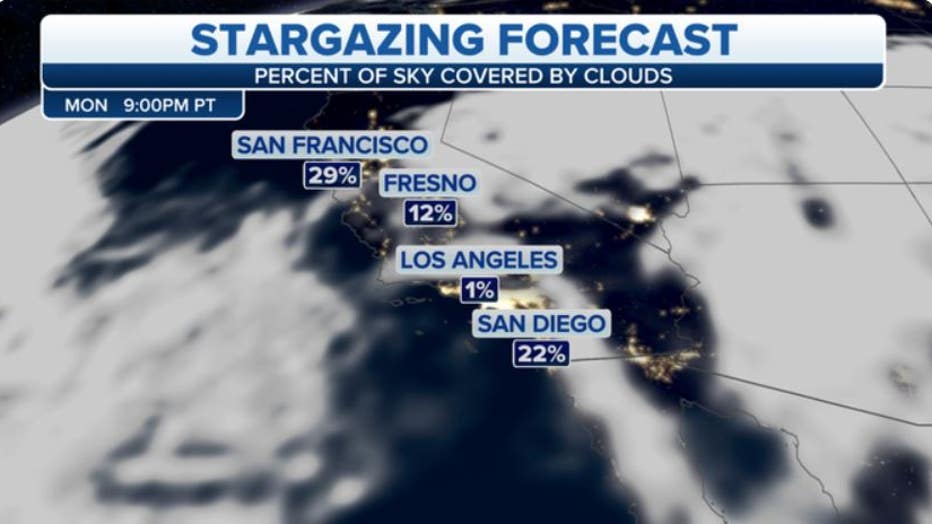Moon will eclipse Mars next week; here's how and when to see it

FILE - Mars is seen in conjunction with the Moon over LAquila, Italy, on Jan. 3, 2023. (Photo by Lorenzo Di Cola/NurPhoto via Getty Images)
It’s not every day the moon moves in front of a bright planet, but the likely once-in-a-lifetime event for some parts of the U.S. will unveil next week.
The rare second occultation of Mars will occur on Jan. 30 when the planet disappears from our view directly behind the moon's left side and reappears an hour later on the opposite side.
Patrick So, observatory program supervisor at Griffith Observatory in Los Angeles, said the viewing area is mostly confined to the southern U.S., Mexico, Central America, northwest portions of South America and most of the Caribbean.
While the times vary depending on where you live in the southern U.S., Mars will disappear in the Los Angeles sky at 8:36 p.m. PST and then reappear on the other side of the moon at 9:30 p.m. PST. The timing would be later for areas farther east in the southern U.S.
"For other parts of southern U.S., those times vary mainly because of the parallax of the moon, and that's why you can't see it further north the moon misses Mars," So said.
If you look to the sky at about 8 p.m. PST, Mars and the waxing gibbous moon will be separated by almost one-quarter of a full moon. As Mars begins to disappear on the unlit side of the moon, it will take about a minute for the moon to completely cover the planet’s finite diameter before disappearing.
"The occultation is almost like an eclipse of Mars by the moon," So said.

What causes a 'blood moon' eclipse?
Here's why the moon will appear red during the upcoming lunar eclipse.
It happens because all the planets in the solar system orbit roughly on the same plane as Earth. As the planets move across the sky, they move along an ecliptic – the path in which the sun, planets, and the moon follow.
"Because the moon is kind of close to the plane for where all the planets move across the sky, it occasionally will encounter a planet and move in front of it, and so you get an occultation," So said.
Before next week’s occultation, the full moon last moved in front of Mars on Dec. 7, 2022. If you might think it’s not so rare, it is uncommon to have two such occultations in less than two months at night, So added.
The next Mars occultation visible through most of the U.S. will be on Jan. 13, 2025.
"When I say they are rare, they are not as rare as a total eclipse which occurs in any location on average about 375 years," So said.
The reason we see them less often, So added, is that they occur in different parts of the world.
"Sometimes these occultations occur during the daytime where we can't see it," he said. "We pay attention because this happens during the night, and we can see it."
The FOX Forecast Center said computer forecast models show a large upper-low spinning over Southern California early next week. Cloud coverage is forecast to be near 0% in Los Angeles, but that number is expected to change as we get closer to the event.

Here's a look at the percent of the sky covered by clouds in Southern California at 9 p.m. PST on Monday, Jan. 30, 2023. (FOX Weather)
According to Griffith Observatory, if skies are clear, the occultation will be visible to the unaided eye from anywhere in Southern California.
"You can actually go out in the evening, and when it's dark, you can look just above the constellation Orion the Hunter. Above that and to the right of it is a constellation Taurus the Bull, and Mars is currently located in that constellation. You can't really miss it. It’s the brightest, reddish object in that area of the sky."
It is safe to view an occultation without any eye protection. If you have a pair of binoculars, it can enhance and magnify the view of Mars and the moon.
"If the people have a chance to go out and the sky is clear, just go ahead and enjoy this spectacle," So said. "It's going to be another long wait until you see this happen again."
The Griffith Observatory will hold a live online broadcast Monday for the lunar occultation of Mars. Click here to join the discussion.

